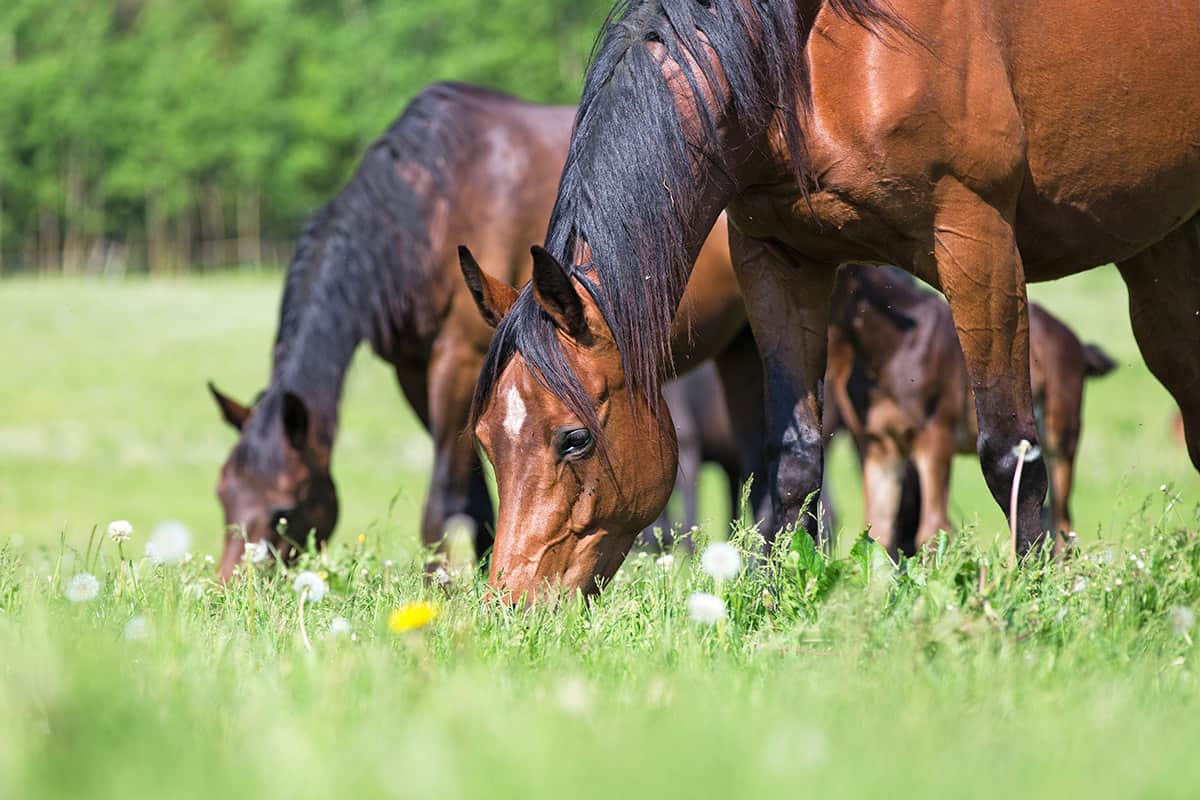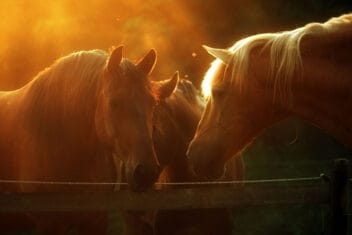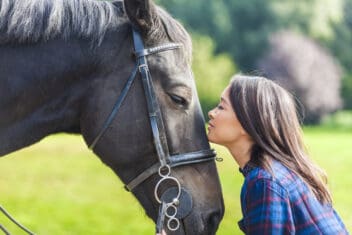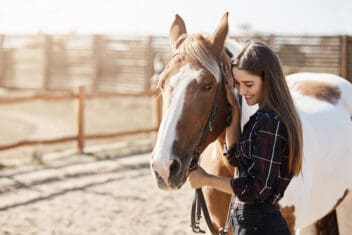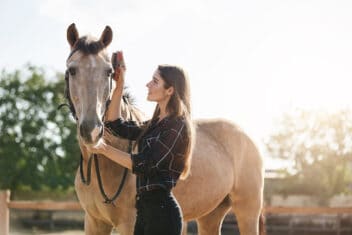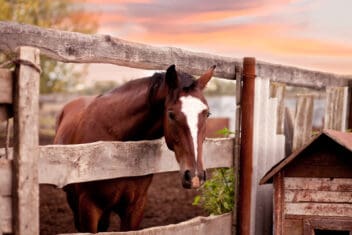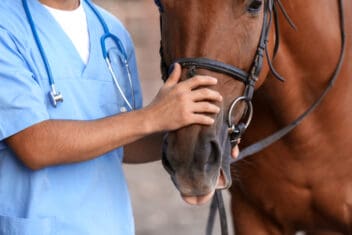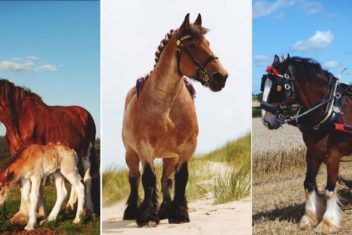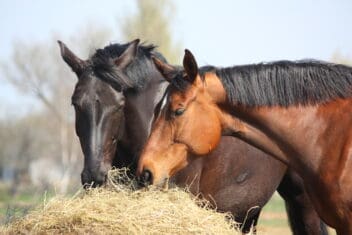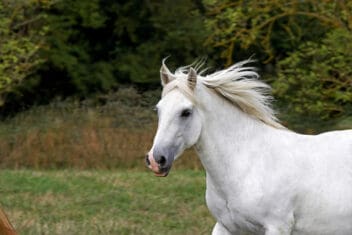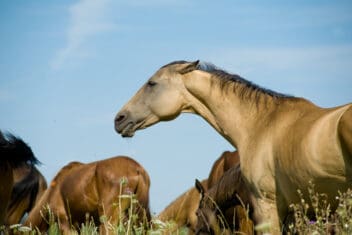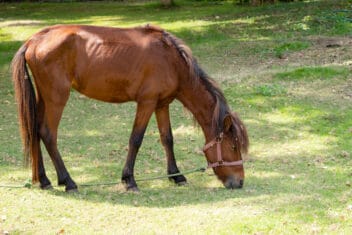Anyone who spends a lot of time around horses knows that there are horse-friendly plants and those that are harmful to them. Unfortunately, our equine friends don’t always know which are which. As a result, it’s up to us to keep horses away from plants that are poisonous to them.
Below is a list of some of the plants that are the most poisonous to horses. Some are more harmful than others, but all should be avoided as best you can.
1. Horsetail (Equisetum spp.)
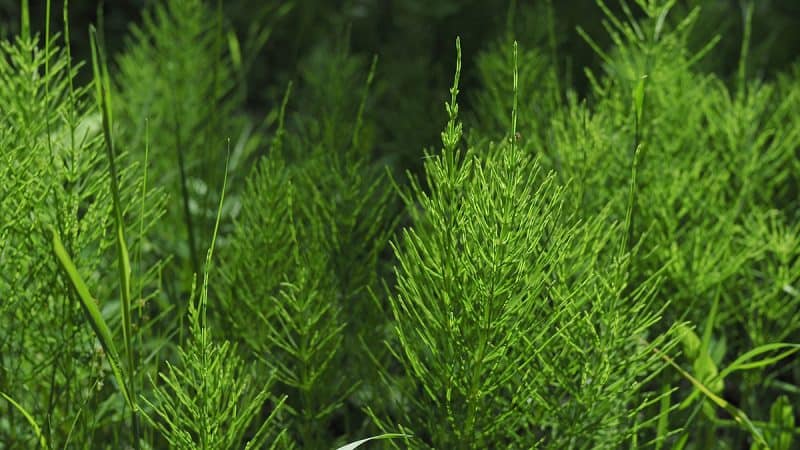
Horsetail plants thrive in sandy soil, usually close to creeks, riverbeds, and marshy wetland areas. There’s a toxin in it that attacks and can even destroy vitamin B in horses, and dried horsetail is more toxic to them than fresh plants.
Symptoms of horsetail poisoning can include depression, blindness, hindquarter weakness, liver failure. If left untreated, it can lead to eventual death.
2. Poison Hemlock (Conium maculatum)
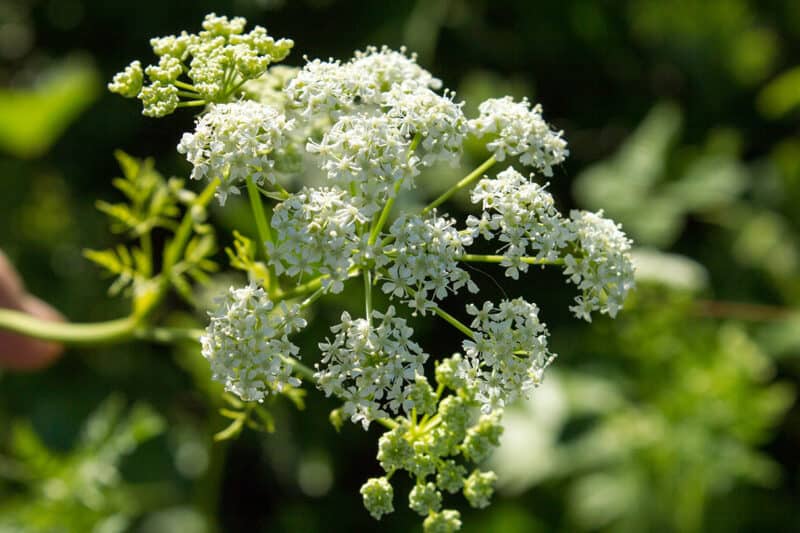
This plant is poisonous to almost every species that might ingest it, including humans and horses. People and horses alike can be accidentally poisoned by it if they mistake it for its lookalike cousin, Queen Anne’s lace.
This hemlock grows in lowland, swampy areas, and can sometimes accidentally be harvested for silage. As few as two pounds of poison hemlock is considered a fatal dose for a 1000lb horse.
Since death from Conium poisoning can happen within a couple of hours, quick treatment is vital. If you see your horse ingest it, call your vet immediately. Initial symptoms include drooling, dilated pupils, disorientation, and muscle tremors. These will quickly deteriorate into collapse, coma, and death.
3. Water Hemlock (Cicuta spp.)
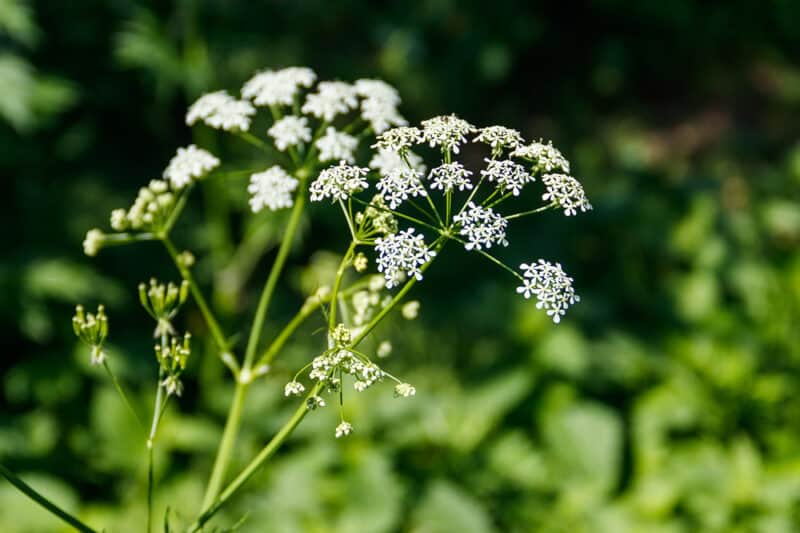
Symptoms are similar to the poison hemlock mentioned above, only more severe, and accelerated. While poison hemlock can kill within hours, death can occur in as little as 20 minutes with Cicuta spp.
Horses will start twitching and frothing at the mouth almost immediately, grinding their teeth and throwing their heads back. Pupils will dilate, limbs will stiffen, and they’ll exhibit a rapid pulse and labored breathing. Seizures are next, followed by sudden death.
4. Oleander (Nerium oleander)
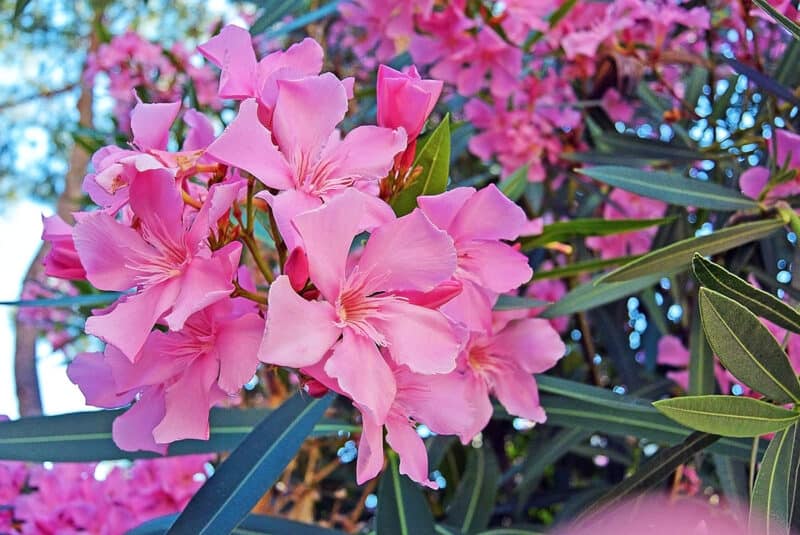
Oleander bushes are incredibly beautiful and thrive throughout the southern US states. They’re most common in South Carolina and Georgia and are most often found in coastal areas. These plants are just as poisonous to horses as they are to humans, whether dried or fresh.
Poisoned animals will often stumble around, weak-limbed, with muscle tremors and labored breathing. Colic and diarrhea may occur as well, and most horses die 8–10 hours after being poisoned unless treated. Your best bet is prevention, so make sure there are no oleander plants anywhere near your property.
5. Jimsonweed (Datura stramonium)
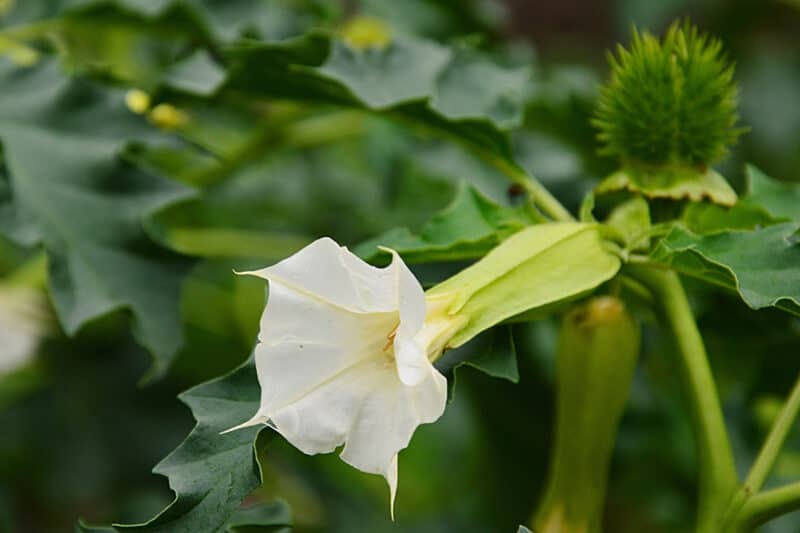
Datura plants are strikingly beautiful but are as deathly poisonous to horses as they are lovely to look at. These nightshade plants contain three toxic alkaloids: scopolamine in the immature roots, atropine, and hyoscyamine. The latter two show up as the plants mature.
Horses that ingest datura can display a fast, weak pulse, pupil dilation, lack of muscle coordination, trembling, and uncharacteristically aggressive behavior. Basically, they can behave the same way a human would while having a psychotic episode after taking hallucinogens.
6. Dutchman’s Breeches (Dicentra cucullaria)

If your pasture borders on a forest of maple trees, keep an eye out for this woodland flower. Although many people grow it decoratively, it grows wild in maple woods all over North America.
It takes 36 to 48 hours after ingestion for symptoms to appear in horses or cattle. Trembling and convulsions occur, along with labored breathing, vomiting, frothing at the mouth, and diarrhea.
7. Deadly Nightshade (Atropa belladonna)
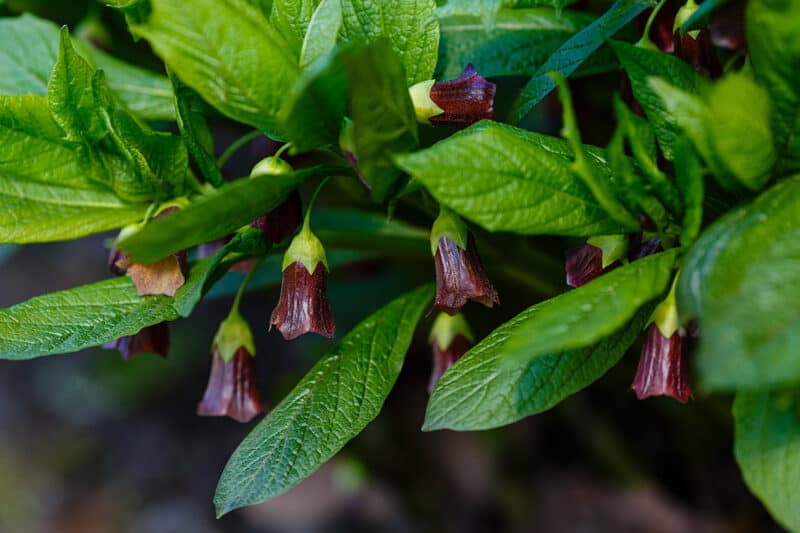
Nightshade can show up in countless different wild places. It often makes its appearance in wild fields or old pastures and likes to climb up fences and posts. Horses generally avoid it, but some might make its way into harvested silage.
Abdominal pain and loss of appetite are the first symptoms to appear, along with dilated pupils and muscle weakness. Diarrhea often comes next, followed by unconsciousness and death if untreated.
8. Pokeweed (Phytolacca decandra)
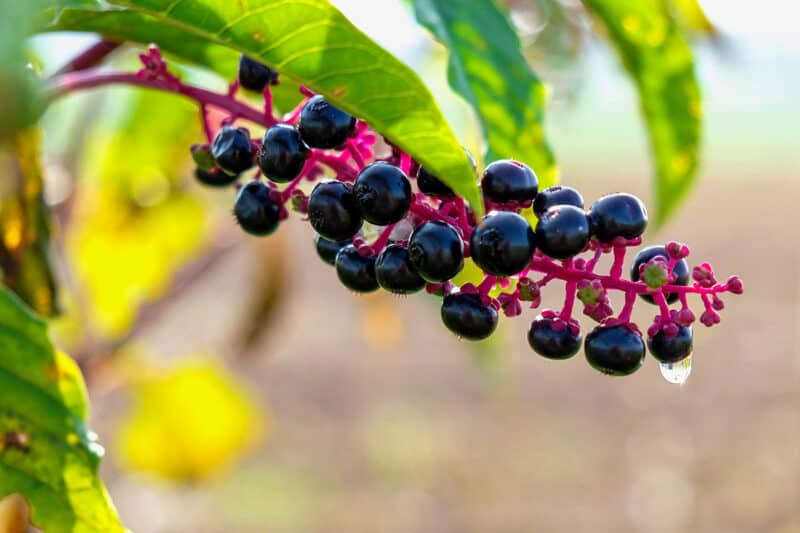
This Appalachian woodland plant grows around forest edges, and around sunny meadows. Although its berries look tasty, they’re incredibly poisonous to humans, horses, and cattle. While the leaves contain many toxic alkaloids, it’s the seeds and roots that are the most dangerous.
About two hours after ingesting this plant, horses will start retching and vomiting. Convulsions follow soon after that, along with lethargy and anemia.
9. St. John’s Wort (Hypericum sp.)
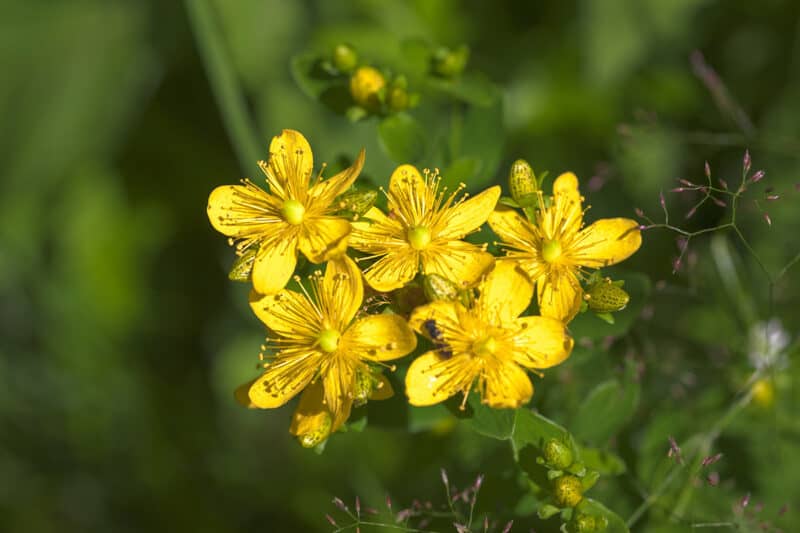
Many homesteaders grow St. John’s Wort in their medicinal gardens, and with good reason! This is an invaluable healing herb, but it’s dangerous for horses to get into. It’s unlikely to kill any of your animals, but it can make them photosensitive.
Lighter parts of their bodies, such as their noses and foreheads, might burn very easily in the sun. Additionally, their lips and tongues might swell, blister, and peel.
10. Avocado (Persea americana)
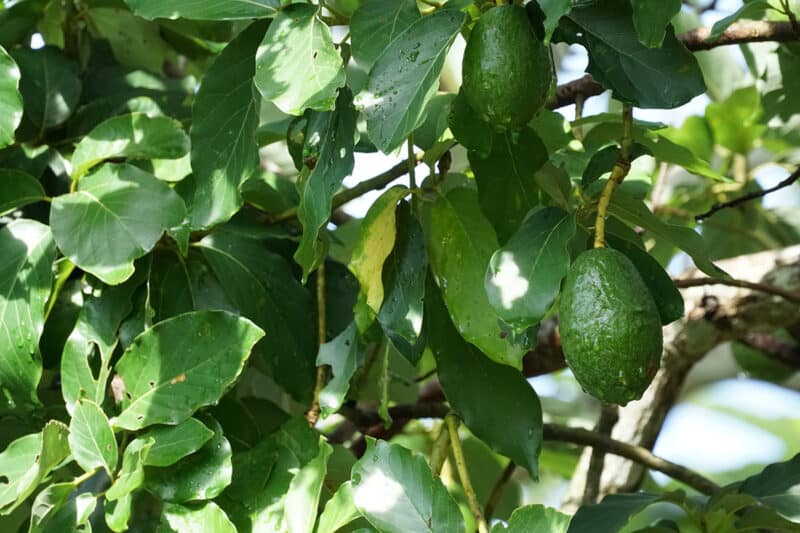
Did you know that every single part of an avocado tree is poisonous to horses? Although the twigs and bark contain the same toxic components, it’s the leaves that can cause them the most damage.
Horses that eat any part of an avocado tree can display loss of appetite, labored breathing, irregular heartbeat, and overall weakness. Swelling of the mouth, tongue, and face follow, along with severe respiratory distress, fluid retention around the heart, and physical collapse.
11. Lambsquarters (Chenopodium album)
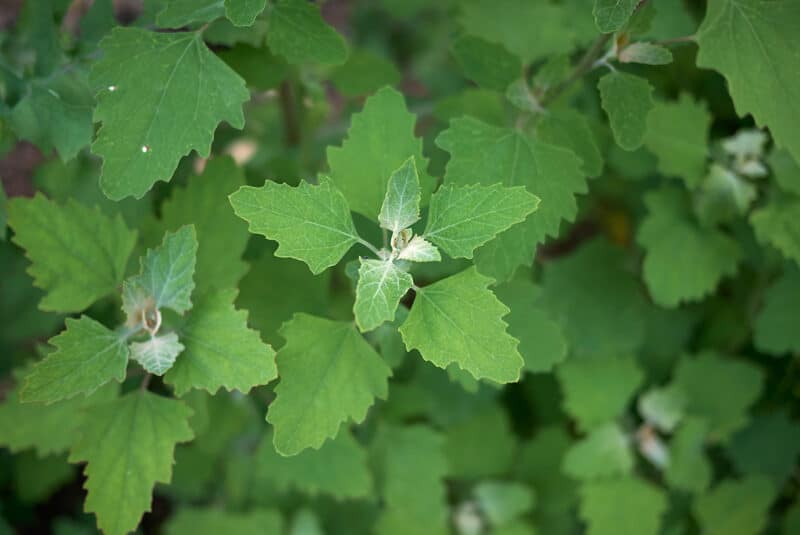
Although this plant is a delicious wild green, it also contains high amounts of oxalic acid. Horses don’t generally eat much of it but will consume it if there’s nothing else available. Fortunately, it would take a huge amount of lambsquarters to have a harmful effect on them.
Horses that gorge on these plants might exhibit muscle weakness, kidney failure, and respiratory distress before falling into a coma.
12. White Snakeroot (Eupatorium rugosum)
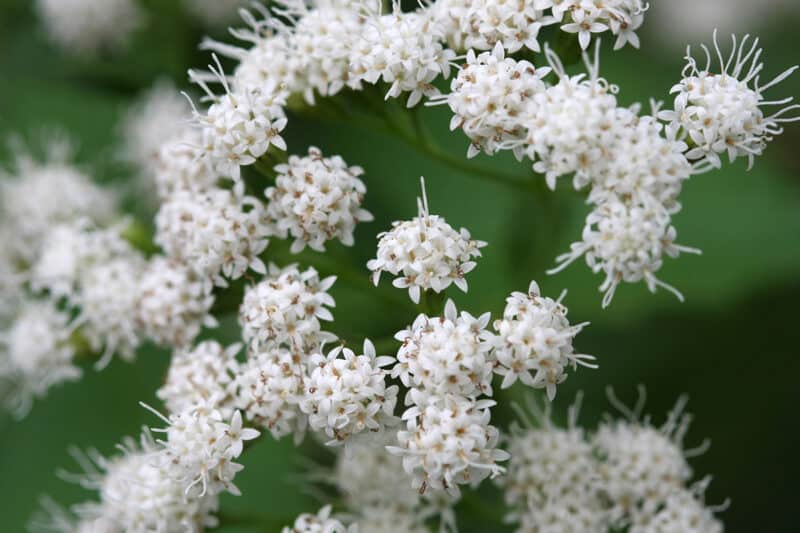
This plant thrives along riverbanks and throughout wooded areas across North America. It’s a highly poisonous (albeit very pretty) perennial, with big fluffy flower heads.
If horses accidentally ingest this stuff, they often exhibit their discomfort by arching their bodies with their hind feet together. They drool heavily and have excessive nasal discharge, and may vomit. They’ll also have labored, rapid breathing, and can get lethargic and depressed.
13. Marsh Marigold (Caltha palustris)
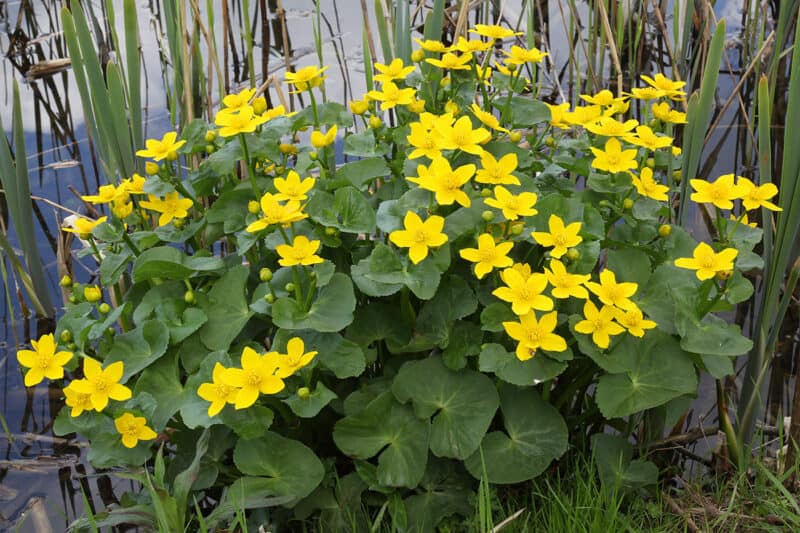
As their name implies, marsh marigolds thrive in wetlands all over North America. They may be pretty, but the symptoms they can cause in horses are far from pleasant.
Symptoms appear about an hour after ingestion and begin with colic, vomiting, strained breathing, and a weakened pulse. The horse’s eyelids may twitch, and they may have diarrhea and/or bloody urine, depending on how much they’ve eaten. Lactating mares might have slowed milk production, and their milk will be reddish in hue and bitter to the taste.
14. Sneezeweed (Helenium automnale)

You’ll find acres of this plant growing in ditches, riverbanks, and other wasted areas throughout the midwest. They’re most common in Missouri and Illinois but appear in Kansas and Iowa as well. This plant is considered poisonous to horses, though death is rare.
It may take a while for symptoms to show, but begin with labored breathing, drooling, fever, rapid pulse, and convulsions. The horses might lose muscle control and seem weak and lethargic and may exhibit rapid weight loss as well.
15. Tansy Ragwort (Senecio jacobaea)
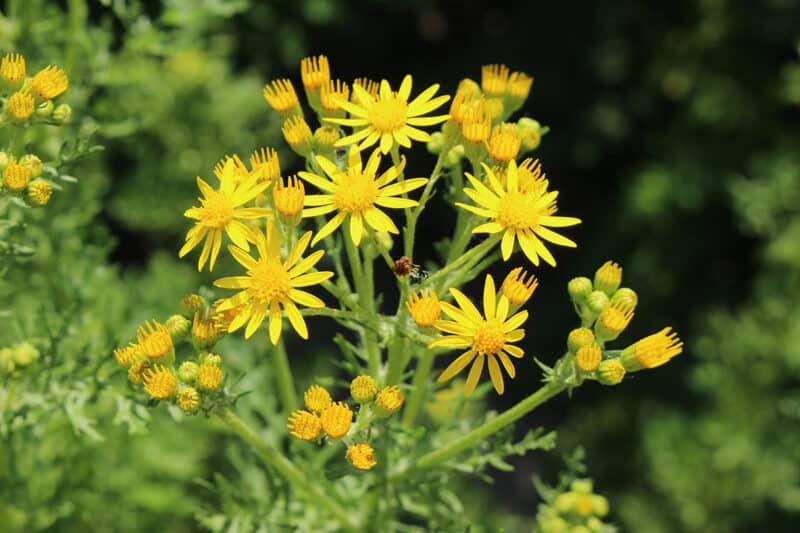
This plant mostly inhabits the Pacific Northwest, where it grows in pastures, hayfields, and woodlands. Most horses and cattle dislike its taste and texture, so they avoid it unless they’re starving. That said, it can sometimes find its way into silage.
Horses that eat it accidentally often exhibit chills and uncontrollable shaking, with a rapid, weak pulse and fever. They may stumble around weakly, disorientated, until they finally fall over. If they’ve ingested significant amounts, or if they’re left untreated, death follows within days.
16. Bracken Fern (Pteridium aquilinum)
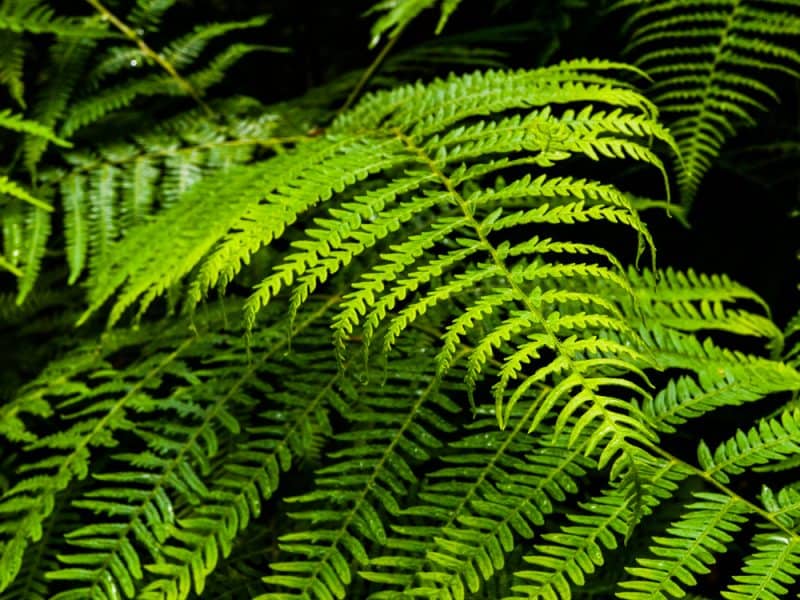
Many people have accidentally poisoned themselves by eating bracken fern sprouts, mistaking them for their non-toxic lookalikes: fiddleheads. These beautiful but toxic plants grow in dry, depleted, rocky soils around heavily wooded areas.
If horses eat these, they won’t show symptoms for a day or two. They might go off their food, and stagger around weakly. Jaundice and nausea may develop, and they may also exhibit hindquarter paralysis.
17. Spurge (Euphorbia maculata)
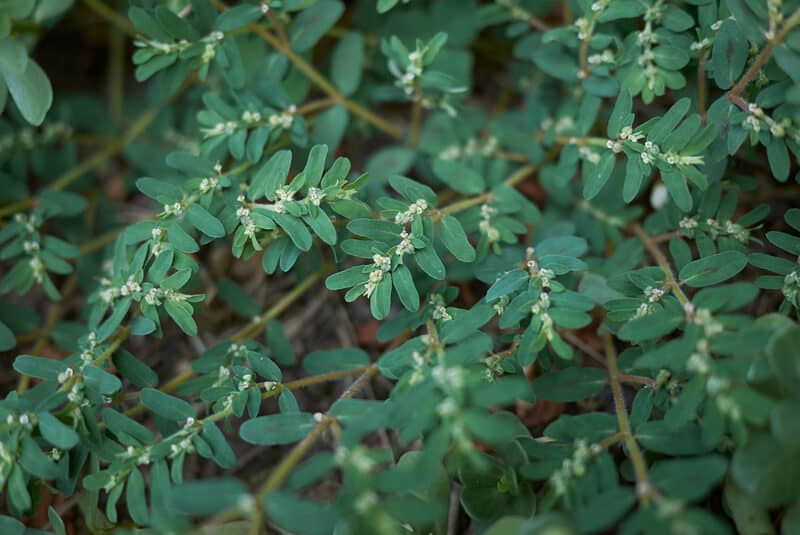
If there are depleted pastures and rural roadways near you, then you might have encountered spurge before. It’s a clumping perennial that has greenish-yellow flowers atop fleshy leaves.
The sap is an irritant and can cause blistering and redness on the horse’s skin. If they happen to eat any of it, they may show swelling around the mouth, face, and eyes, along with sweating, vomiting, diarrhea, and muscle tremors. Lactating mares may start giving red or pink milk.
18. Buttercup (Ranunculus spp.)
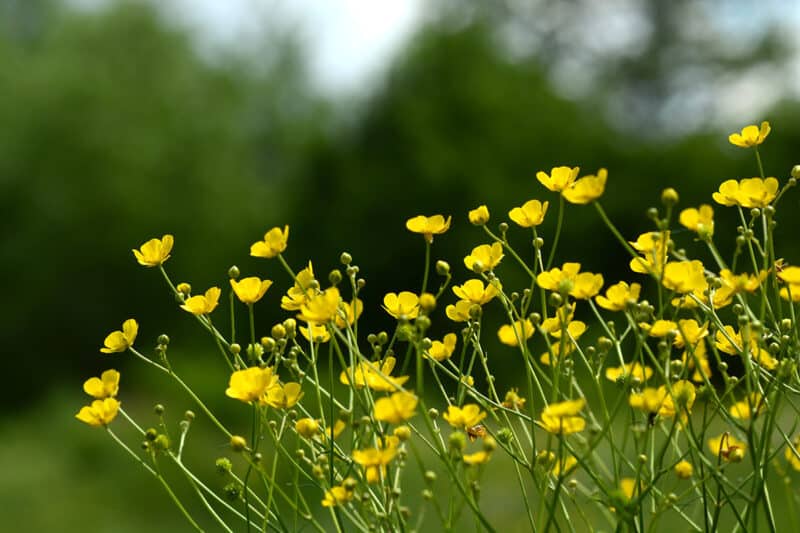
Considering how many horses out there are named “buttercup”, you’d think that they’d be able to eat these friendly little yellow flowers. Unfortunately, all buttercups are poisonous when they’re fresh and juicy. They’re so acrid that they cause blistering on contact, both in the mouth and through the GI tract. Dried buttercups in hay are safer, but still best avoided.
Horses usually only eat buttercups if there’s literally nothing else around. Symptoms of poisoning can include severe blisters around the horse’s mouth, drooling, and bloody diarrhea.
19. Lily of the Valley (Convallaria majalis)
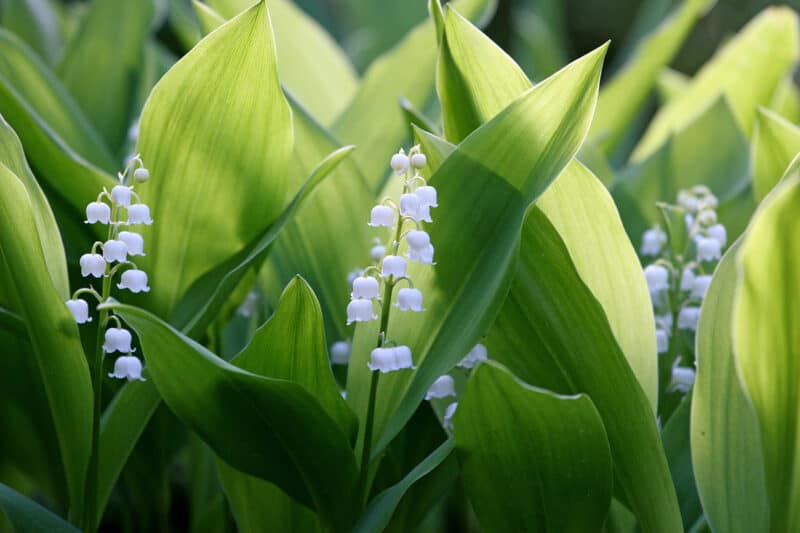
These beautiful flowers are some of the first to show up in springtime. They prefer slighted shady, wooded areas, and release their scent in the evening. Unfortunately, every single part of this plant is incredibly poisonous to horses.
Signs that your horse has eaten lily of the valley can include abdominal colic, diarrhea, heart palpitations/irregularities, weakness, or sudden death.
20. Cockles (Vaccaria hispanica)
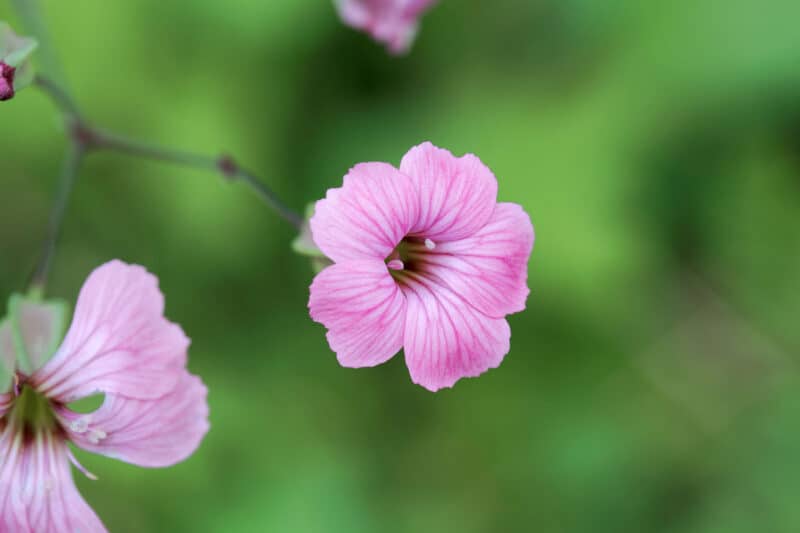
Cockles are also called spring cockles, cow cockles, or dairy pinks. They grow in depleted soils, usually in fields that have previously been used to grow wheat. They feature pretty pink flowers atop long stems, which will kill horses, sheep, and other livestock if they eat them.
These plants cause severe liver issues, which can lead to complete hepatic failure and death. Early symptoms can include diarrhea, weakness, and shaking.
21. Milkweed (Asclepias syriaca)
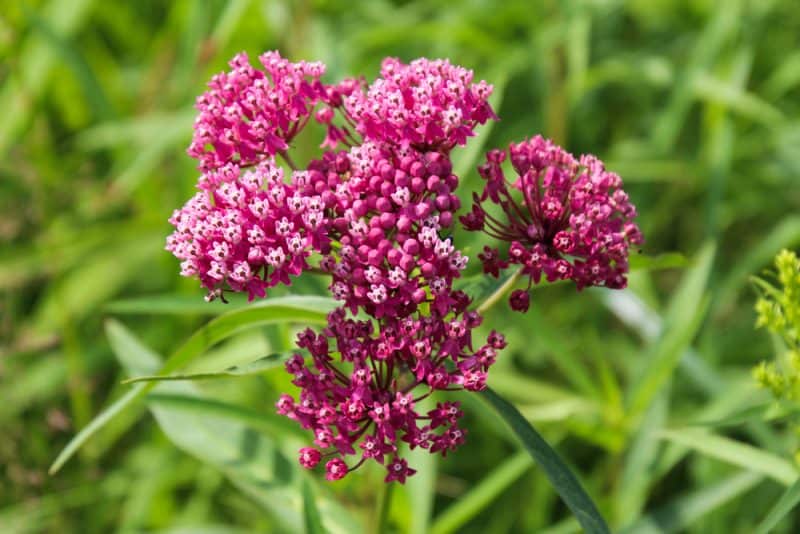
It’s rare that horses will feed on milkweed, as they find the sticky “milk” in the stems, leaves, and pods unpalatable. The only time they’ll eat this stuff is if all other food sources are depleted, and they have no other options available.
Horses that eat milkweed can exhibit spasms and muscle control loss, respiratory stress, weak and rapid pulse, and general disorientation.
22. Rhododendrons (Rhododendron spp.)
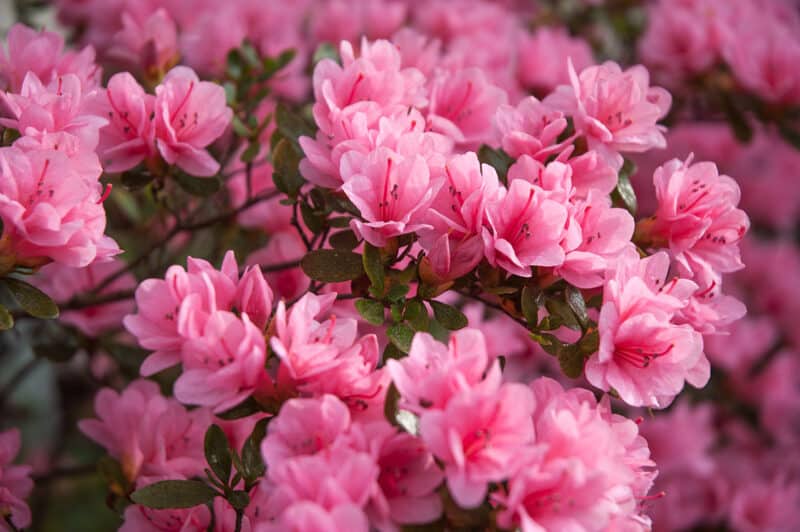
A lot of people grow rhododendron species like azaleas as decorative plants, but they’ve also become naturalized throughout the Appalachian mountains and rhododendrons grow native across the Pacific Northwest. Horses generally don’t eat them, but can accidentally ingest them in wintertime when other fresh forage isn’t available.
The grayanotoxins in the plants interfere with cardiac and nerve function and can cause weakness, salivation, diarrhea, weak pulse, stupor, and paralysis. These symptoms generally last two to three days. After this time, there will either be improvement, or coma followed by death.
23. Potato Leaves (Solanum tuberosum)
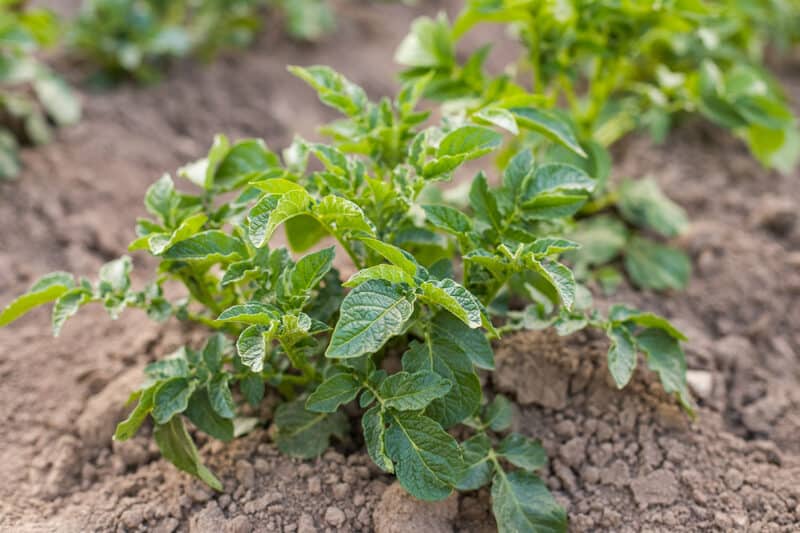
If you grow potatoes on your homestead, keep them well away from your horses. Every part of these plants are poisonous to horses, especially the leaves. They’re part of the nightshade family, and contain solanine just like belladonna.
Additionally, horses have been known to drop dead from arsenic poisoning after eating old, green potatoes that rolled into their paddock areas.
24. Tomatoes (Solanum lycopersicum)
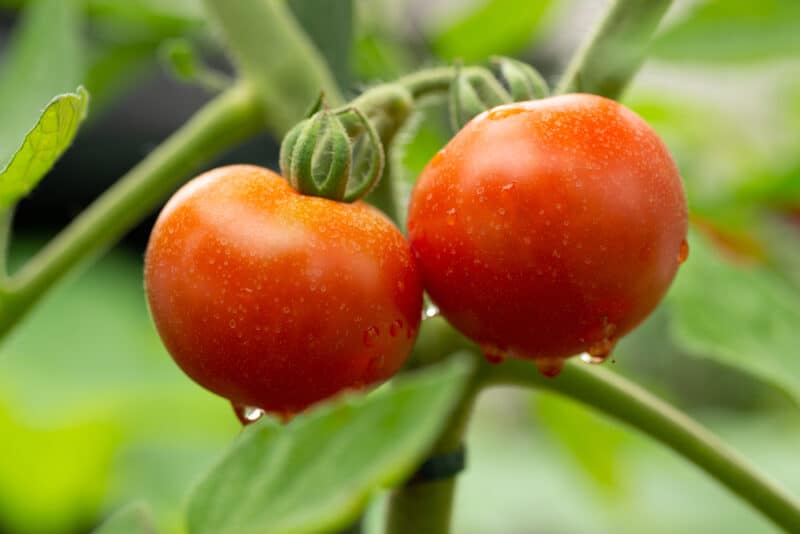
These are also nightshade plants and have a similar effect to potatoes and datura if ingested. In this case, it’s the leaves and unripe fruits that can cause the most damage. They contain solanine and demissine, albeit in small amounts.
These symptoms begin with facial swelling, pupil dilation, and drooling. This is followed by colic and diarrhea, with weakened heart rate and labored breathing. Death from tomato poisoning is rare, but do your best to prevent any risks by keeping your tomato garden well fenced in.
25. Castor Beans (Ricinus communis)
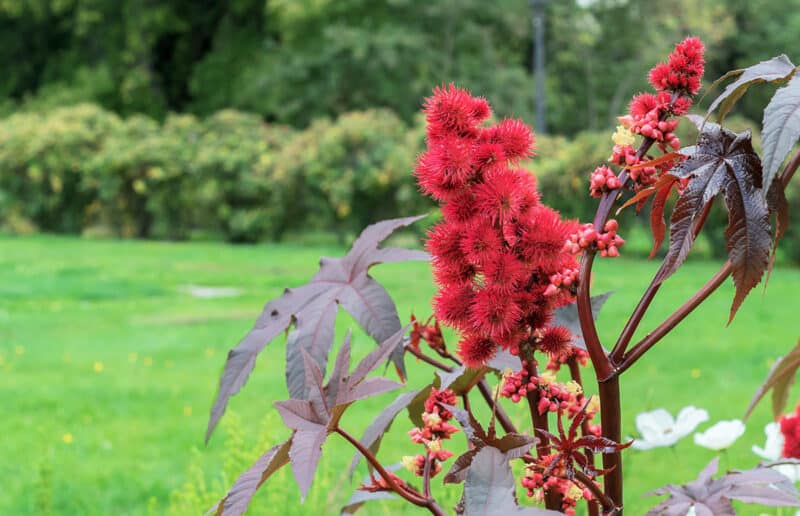
If you’ve seen Breaking Bad, you probably remember that a deadly poison called ricin was made from the castor bean plant. The alkaloids in this plant cause the central nervous system to shut down, and there is no antidote. Familiarize yourself with what this plant looks like, and remove it from your property entirely if you have horses. Just in case.
Since this plant causes oral irritation and burning, your horse may start drinking water excessively. They’ll display muscle weakness, fever, and sweating, followed by convulsions. Kidney failure will lead to coma, and death occurs within 36 hours.
26. Lupines (Lupinus polyphyllus)
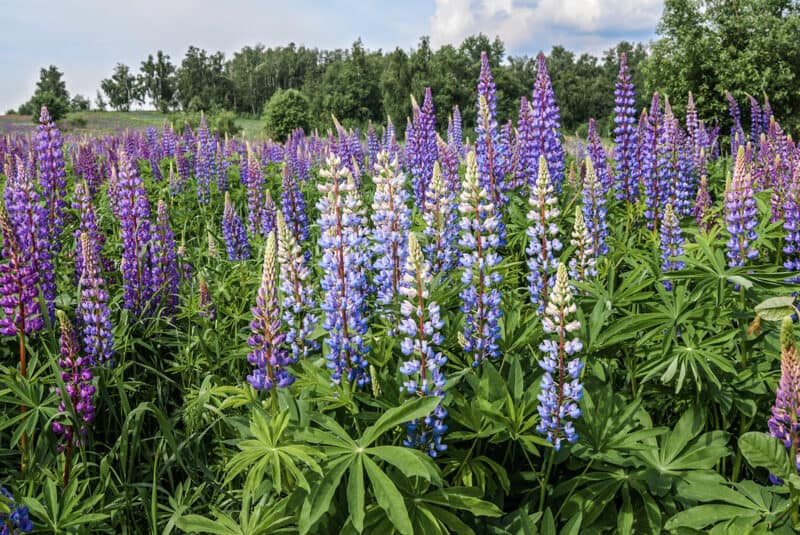
Although lupins bathe wild fields in glorious purple every spring, you don’t want your horses to nibble on them. Their leaves, seeds, and pods all contain quinolizidine alkaloids, which attack the nervous system.
Horses that ingest lupins display confusion and dizziness, along with muscle spasms that give way to full-body convulsions. As the toxins affect the respiratory system most, death is generally caused by respiratory arrest. This means that they will be unable to draw breath, which may, in turn, lead to cardiac arrest.
27. Ground Ivy (Glechoma hederacea)
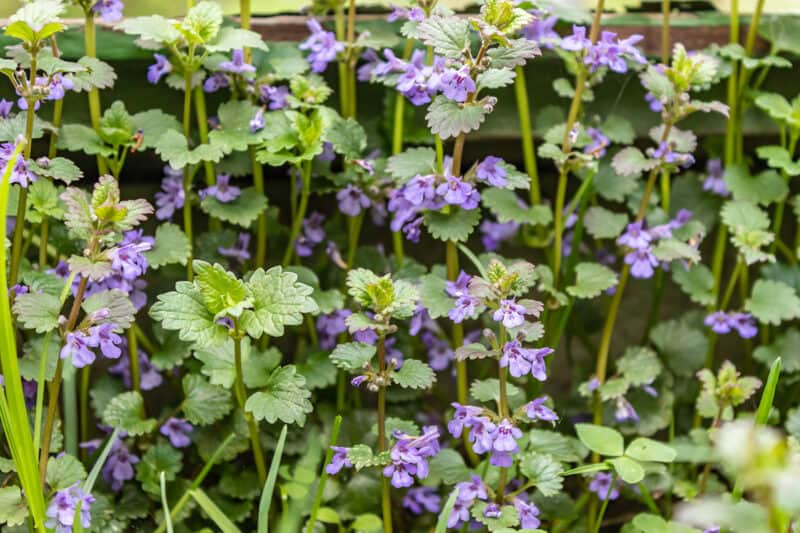
Although this low-creeping perennial plant is edible by humans, it’s toxic to horses and rabbits. It’s a member of the mint (Lamiaceae) family, and as such may seem appealing to them when grazing in open fields and pastures.
If a horse eats it, symptoms can include rapid breathing, drooling, frothing at the mouth, sweating, and tremors. Ingestion is rarely fatal but can cause long-term kidney damage if eaten in large amounts.
28. Chokecherry (Prunus virginiana)
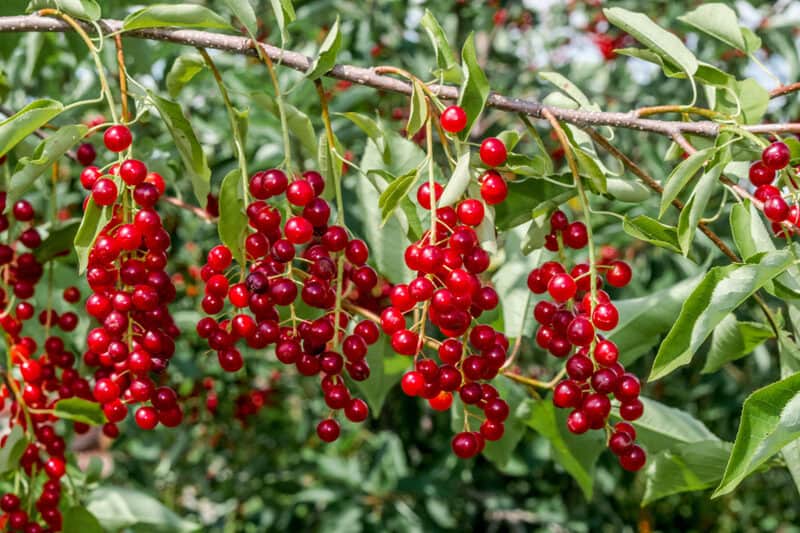
All Prunus genus plants have leaves and twigs that are toxic to horses. These include plum, peach, apricot, and cherry trees, but wild cherries and chokecherries are the most lethal. All of these plants create a type of cyanide in their leaves and pits, so only a small amount can be fatal if ingested. Cyanide kills by preventing oxygen from moving through the bloodstream, so animals that eat it basically suffocate on a cellular level.
Shortly after eating these leaves, horses will display anxiety and distress, along with weakness and muscle trembling. They’ll flare their nostrils and widen their eyes as they have greater difficulty breathing, and they will lose urinary and bowel control. After that, they will have seizures and collapse. Death is preventable with immediate veterinary care.
29. Marsh Arrow-Grass (Triglochin palustris)
This wetland plant is found in boggy soils along both the Northwest and Northeast coasts of the USA and Canada. It’s quite unremarkable, and horses tend to avoid eating it when there are tastier options available. However, if they do ingest it, this plant is quite poisonous for horses.
Symptoms come on quite quickly and include a rapid pulse and shallow, short breaths. The horse’s breath might take on an almond-like scent, and they might drool or foam at the mouth. If the horse has ingested quite a bit, it may collapse with its head tilted to one side, with wide eyes.
30. Larkspur (Delphinium spp)
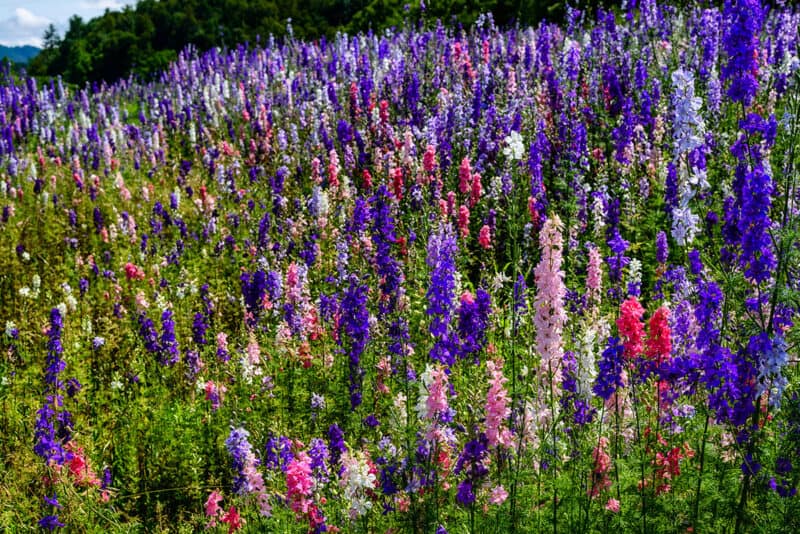
These beautiful decorative flowers contain high levels of delphinine. The young leaves, branches, and flower buds are most toxic, but the mature blooms are deadly as well.
Early symptoms include behavioral changes such as nervousness and confusion, as well as rapid pulse and breathing. Horses may start salivating excessively and twitching before their muscles weaken. They’ll then stagger around until they collapse. Death can come on suddenly if left untreated.
31. Tobacco (Nicotiana tabacum)

The nicotine in tobacco might be fun for a lot of people, but it’s decidedly poisonous to horses. Animals need to eat quite a bit of it in order to cause harmful symptoms, but if you catch them eating it, make sure to get them veterinary attention as soon as possible.
Early symptoms include confusion and drooling, as well as confusion and staggering. Horses may have muscle tremors and seizures before collapsing with labored breathing. Vets will often administer activated charcoal and set up an IV drip to help eliminate the toxins. Death is rare.
32. Red Maple Leaves (Acer rubrum)
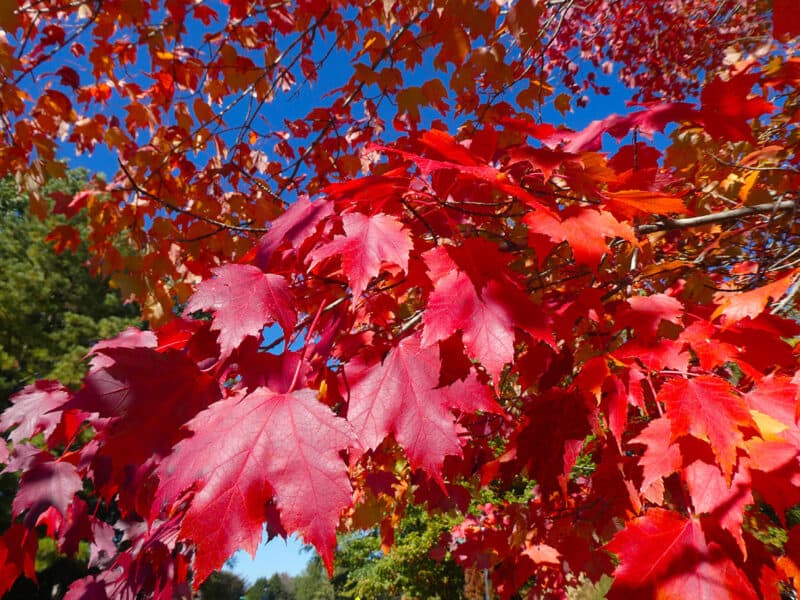
Those red maple leaves that look stunning in autumn are lethal to horses if eaten. They’re full of toxins that attack horses’ red blood cells, and it only takes a few mouthfuls to kill a fully grown quarterhorse. Furthermore, these leaves don’t just stay toxic while on the tree: fallen, drying leaves are more lethal than fresh ones. Cut down any maples near your pasture or paddock, and avoid riding through maple forests between September and December.
Initial symptoms include rapid pulse, shallow, fast breathing, and blue or yellowish gums. Anemia and depression follow, along with discolored, dark brown urine, tremors, collapse, and then death.
33. Red Oak Leaves (Quercus rubra)
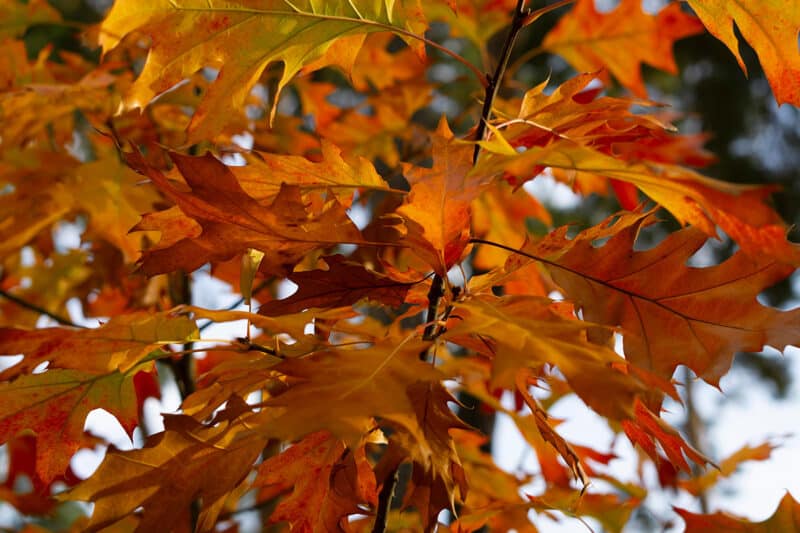
Oak leaves are very acidic, which makes them great for increasing acidity in the soil or treating wounds. That same acidity makes them quite poisonous to horses, unfortunately. Red oak acorns can also cause unpleasant symptoms.
These can include colic, pale gums and tongue, dark brown or bloody urine, diarrhea, depression, and tremors. If the horse has ingested significant amounts, it may display edema in the neck, chest, and abdomen. Kidney failure will lead to collapse and death.
34. Sorghum (Sorghum bicolor)
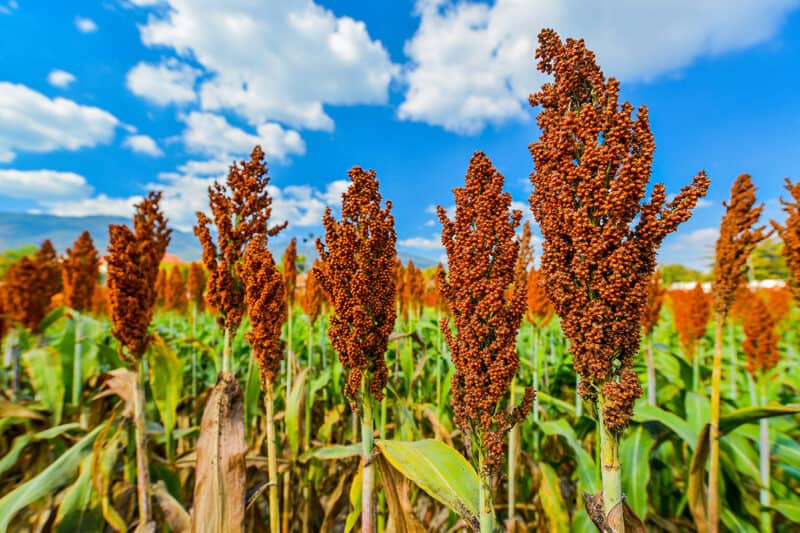
Although sorghum is a great grain plant for the homestead, it’s incredibly poisonous to horses. It’s also insidious because the effects are long-term rather than immediate. Sorghum toxins affect the horse’s nervous system, causing spinal cord neuron degeneration.
The first symptoms are disorientation and urinary incontinence. Pregnant mares may spontaneously abort, or give birth to deformed foals. Although death is rare, the horse may develop chronic urinary tract infections and cystitis. Full recovery is rare.
35. Bermuda Grass (Cynodon dactylon)
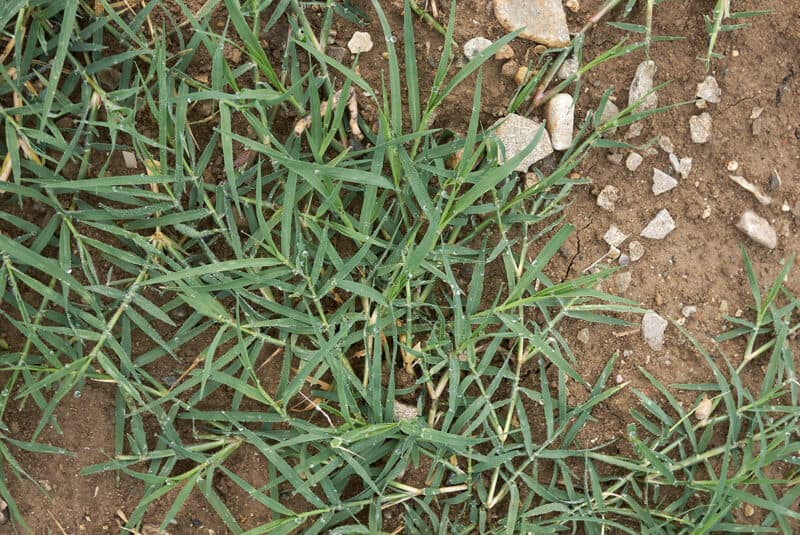
While Bermuda grass isn’t poisonous on its own, it’s susceptible to a blight called ergot, which can be extremely dangerous to your horses. Ergot can cause tremors, convulsion, rolling tongue and eyes, and full-body paralysis. Additionally, pregnant mares can spontaneously abort.
This grass can also cause impaction colic and bloat, which requires immediate veterinary care. Although most respond well to nasogastric tubing with mineral oil and water, they often require emergency surgery to remove the blockage. Bermuda grass hay is 6 to 10 times more likely to cause colic in horses (and rabbits) than any other hay.
As you can see, there are many species that can harm or even kill our beloved horses. As research is still continuing, we may add to this list in the future. Keep checking back for additional information! We can work together to keep our equine companions safe and healthy, and share this info with others too.
